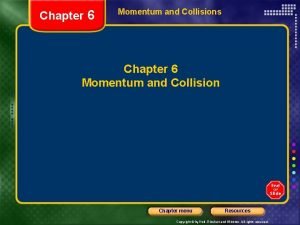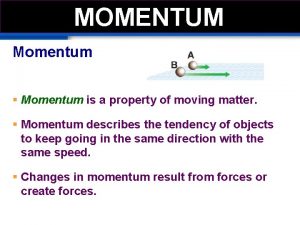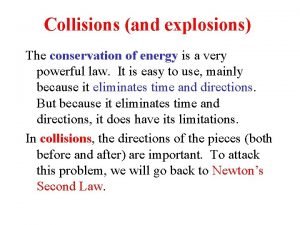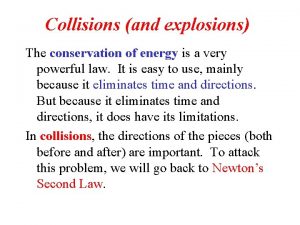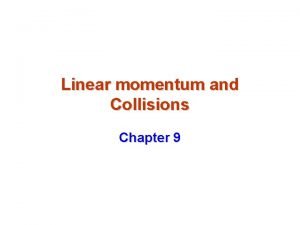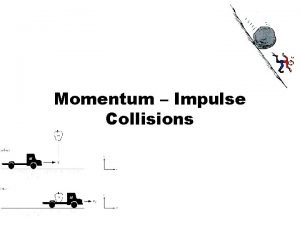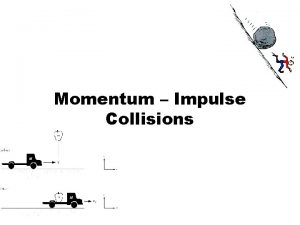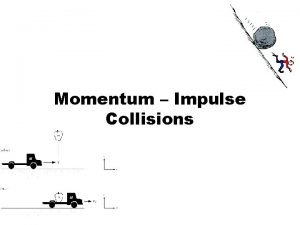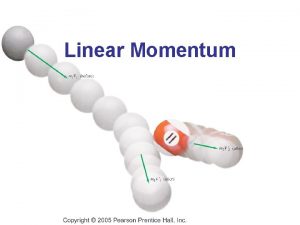MOMENTUM AND COLLISIONS Momentum is similar to inertia














- Slides: 14

MOMENTUM AND COLLISIONS

Momentum is similar to inertia - the tendency of an object to remain at a constant velocity. Where as inertia depends only on mass, momentum depends on mass AND velocity.


Consider this: A tennis ball traveling at 10 m/s and a medicine ball traveling at 10 m/s. Which one is more difficult to stop? OK now this one: A baseball traveling at 5 m/s and a baseball traveling at 50 m/s. Which one is harder to stop?

A force acting on a 5 kg body increases its speed uniformly from 2. 0 m/s to 8. 0 m/s. What is the initial and final momentum of the body? What is the change in momentum? How fast would a 125 kg object have to move to achieve the same change in momentum? How massive would an object be if it has the same change in momentum when moving from 0 to 20 m/s?

Example: A baseball pitcher hurls a 0. 45 kg ball at 32 m/s. The batter crushes it and the ball leaves the bat at 48 m/s in the opposite direction. What was the ball’s change in momentum? Remember that momentum is a VECTOR which means we have to consider its DIRECTION.


A ball is hit by a bat. The impact force is 250 N, and the contact time is 0. 2 s. What is the impulse received by the ball? A volleyball is spiked so that its incoming velocity of 4 m/s is changed to an outgoing velocity of 17 m/s. If the mass of the ball is 0. 6 kg, what is the impulse provided?

How long must a 50 N force act on a 400 kg mass to raise its speed from 10 m/s to 12 m/s? A 1200 kg car crashes into a wall. The impulse is 4000 Ns and the impact time is 0. 5 s. What is the impact force on the car? How fast was the car going when it hit the wall?

A 75 kg skateboarder is initially going 5 m/s to the right. He slows to a stop over 10 seconds. a) What is the direction and magnitude of the net force that causes this change? b) If the skateboarder had to stop over 2 seconds rather than 10 seconds, what would need to be the direction and magnitude of the net force? c) When we changed the time over which the skateboarder had to stop, did the impulse experienced by the skateboarder change? Why or why not?

The Law of Conservation of Momentum is a useful quantity because in a closed system it is always conserved. This means that in any collision, the total momentum before the collision must equal the total momentum after the collision. pinitial = pfinal for a collision involving two bodies,

First we are going to consider linear 1 -D interactions. There are 3 general types of these collisions: (1) Collision where the two bodies don’t stick together Example: A 1200 kg car heading east at 35 m/s collides with a 1550 kg truck traveling west at 27 m/s. After the collision the truck is traveling east at 6. 0 m/s. What is the final velocity of the car? Before After m 1 i = m 2 i = m 1 f = m 2 f = v 1 i = v 2 i = v 1 f = v 2 f =

(2) Collision where the bodies do stick together Example: A 9500 kg caboose is at rest on some tracks. An 11000 kg engine moving east at 12. 0 m/s collides with it and they stick together. What is the velocity of the train cars after the collisions? Before After m 1 i = m 2 i = mtotal = v 1 i = v 2 i = vf =

(3) Explosion Example: An object…no wait…a fluffy little bunny suddenly explodes in a stunning display of gore. The bunny splits into exactly two parts, the first part has a mass of 2. 2 kg and flies due east at 26 m/s. The second chunk heads due west at 34 m/s. What was the initial mass of the bunny? Before After mtotal = m 1 f = m 2 f = vi v 1 f = v 2 f = =
 A small marble collides with a billiard ball
A small marble collides with a billiard ball A roller coaster climbs up a hill at 4m/s and then
A roller coaster climbs up a hill at 4m/s and then Elastic collisions
Elastic collisions Chapter 6 momentum
Chapter 6 momentum Is momentum conserved in all collisions
Is momentum conserved in all collisions Momentum vs inertia
Momentum vs inertia Momentum
Momentum Elastic vs inelastic collision
Elastic vs inelastic collision Collisions and explosions
Collisions and explosions Collisions
Collisions What is inelastic collision
What is inelastic collision Similar disuelve a similar
Similar disuelve a similar Propiedades fisicoquímicas del agua
Propiedades fisicoquímicas del agua Lo similar disuelve lo similar
Lo similar disuelve lo similar Members of an avian species of identical plumage congregate
Members of an avian species of identical plumage congregate



